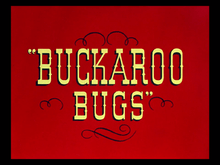Buckaroo Bugs
Buckaroo Bugs is a 1944 Looney Tunes cartoon directed by Bob Clampett.[1] The cartoon was released on August 26, 1944, and features Bugs Bunny.[2]
| Buckaroo Bugs | |
|---|---|
 Title Card | |
| Directed by | Robert Clampett |
| Produced by | Leon Schlesinger |
| Story by | Lou Lilly |
| Starring | Mel Blanc |
| Narrated by | Robert C. Bruce (uncredited, opening) |
| Music by | Carl W. Stalling |
| Animation by | Manny Gould (credited as M. Gould) Robert McKimson (uncredited) Rod Scribner (uncredited) Jack Bradbury (uncredited) |
| Layouts by | Thomas McKimson |
| Backgrounds by | Micheal Sasanoff |
| Color process | Technicolor |
Production company | |
| Distributed by | Warner Bros. Pictures The Vitaphone Corporation |
Release date | August 26, 1944 (USA) |
Running time | 8 min 44 sec |
| Language | English |
Plot
The film is set in a small town of the "San Fernando Alley" (San Fernando Valley).[3][4] According to the narration, "Our story begins when the West was young, and early pioneers settled down to never more roam, and made the San Fernando Alley their home." [5] Despite its Western setting, the short makes references to World War II rationing. A pretend train robbery, lists as "valuable cargo": butter, gasoline, sugar, shoes, and tires – all of them items for which there was a shortage in the War due to rationing.[3] The short also has Bugs stealing all the carrots from a victory garden, which is another World War II reference.[4]
Unlike in most shorts, Bugs Bunny serves as an antagonist. In the cartoon, he plays a carrot thief called the Masked Marauder, whom Brooklyn's "Red Hot Ryder" must bring to justice. The cartoon portrays Red Hot Ryder as a dimwit who cannot distinguish Bugs Bunny from the Masked Marauder, his black horse named Horsey with a mind of its own, and his good-natured slowness is consistently mocked: When Bugs Bunny as the Masked Marauder threatens to shoot Red Ryder, saying, "Stick 'em up, or I'll blow your brains out," the latter treats it like a choice, replying, "Well, now, that's mighty neighborly of you."
In the end, Red Hot Ryder catches on, but is unable to catch the Masked Marauder. Bugs tricks him and his black horse into jumping into the Grand Canyon and they (eventually) crashed down, making a man-and-horse-shaped hole into the ground, Red Hot Ryder finally figures out that Bugs is really the Masked Marauder. Bugs pops up from beneath the ground with a lit candle and says "That's right! That's right! You win the $64 question!" (a reference to the "big prize" on the famous radio quiz show Take It or Leave It). He then kisses him and blows out the candle, with Bob Clampett's "Bey-woop" effect to close the cartoon.
Cast
- Mel Blanc as Bugs Bunny, Red Hot Ryder, Various Villagers
- Robert C. Bruce as Narrator, Various Villagers (uncredited)
Availability
- VHS - Viddy-Oh! For Kids Cartoon Festivals: Bugs Bunny Cartoon Festival Featuring "Hold the Lion, Please"
- VHS - Bugs Bunny Collection: Bugs Bunny on Parade
- LaserDisc - The Golden Age of Looney Tunes, Vol. 2, Side 5: Bob Clampett
- VHS - Looney Tunes: The Collectors Edition Volume 7: Welcome To Wackyland
- DVD - Looney Tunes Golden Collection: Volume 5, Disc 3 (with two commentary tracks: one by Michael Barrier and the other by Spumco workers John Kricfalusi, Eddie Fitzgerald, and Kali Fontecchio)
- Blu-ray/DVD - Looney Tunes Platinum Collection: Volume 2, Disc 1 (with two commentary tracks: one by Michael Barrier and the other by Spumco workers John Kricfalusi, Eddie Fitzgerald, and Kali Fontecchio)
Notes
- "Buckaroo Bugs" and "The Old Grey Hare" use the same opening font titles. They were both also directed by Clampett.
- This was Leon Schlesinger's final Warner Bros. cartoon as producer as he sold the studio to Warner Bros. around the time of the release, though Schlesinger was still involved with the marketing of the characters until his death in 1949.
- This was Bugs Bunny's first short in the Looney Tunes series. At the time, both Merrie Melodies and Looney Tunes were becoming more similar to each other. The Looney Tunes series went into full-time 3-hue Technicolor in 1944.
References
- Beck, Jerry; Friedwald, Will (1989). Looney Tunes and Merrie Melodies: A Complete Illustrated Guide to the Warner Bros. Cartoons. Henry Holt and Co. p. 153. ISBN 0-8050-0894-2.
- Lenburg, Jeff (1999). The Encyclopedia of Animated Cartoons. Checkmark Books. pp. 60–61. ISBN 0-8160-3831-7. Retrieved 6 June 2020.
- Shull, Wilt (2004), p. 165
- Young, Young (2010), p. 746
- "Buckaroo Bugs". imdb.com. Retrieved 1 November 2013.
Further reading
- Shull, Michael S.; Wilt, David E. (2004), "Filmography 1944", Doing Their Bit: Wartime American Animated Short Films, 1939-1945, McFarland & Company, ISBN 978-0786481699
- Young, William H.; Young, Nancy K. (2010), "Victory Gardens", World War II and the Postwar Years in America: A Historical and Cultural Encyclopedia, Volume 1, ABC-CLIO, ISBN 978-0313356520